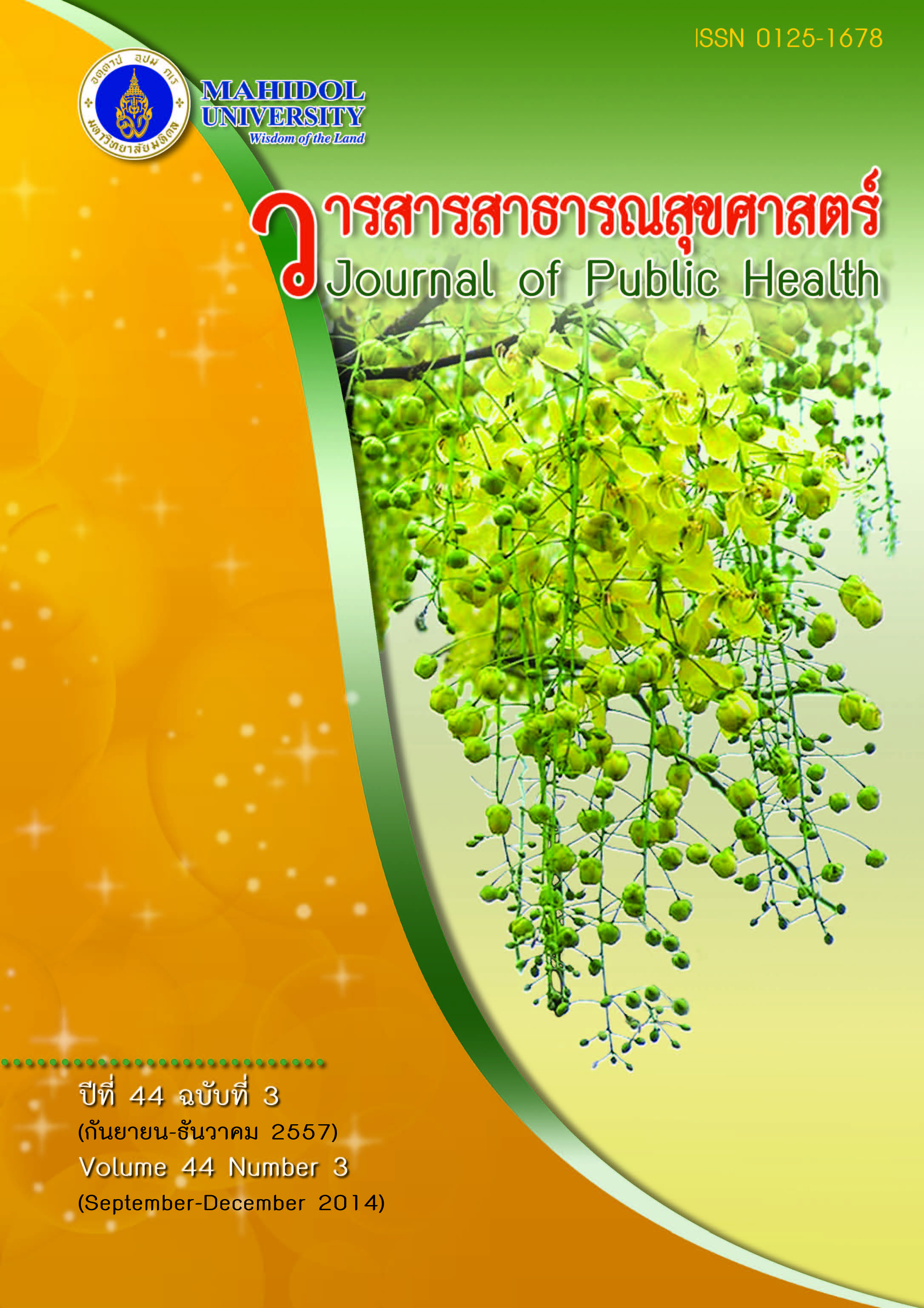ปัจจัยที่มีความสัมพันธ์กับน้ำหนักตามเกณฑ์ส่วนสูงในเด็กนักเรียน ชั้นประถมศึกษาตอนปลายโรงเรียนแห่งหนึ่งในจังหวัดชลบุรี
Keywords:
ความรู้เกี่ยวกับการบริโภคอาหาร, พฤติกรรมการบริโภคอาหาร, พฤติกรรมการออกกำลังกาย, น้ำหนักตามเกณฑ์ส่วนสูง, นักเรียนประถมศึกษาตอนปลาย, Knowledge of food consumption, food consumption behavior, exercise behavior, weight for height, students grade 5 and 6Abstract
บทคัดย่อ
การวิจัยครั้งนี้เป็นการวิจัยแบบตัดขวาง (Cross-sectional Research) มีวัตถุประสงค์เพื่อศึกษาปัจจัยที่สัมพันธ์กับน้ำหนักตามเกณฑ์ส่วนสูงของนักเรียนในโรงเรียนแห่งหนึ่งในจังหวัดชลบุรี กลุ่มตัวอย่างคือนักเรียนชั้นประถมศึกษาปีที่ 5 และ ปีที่ 6 โดยทำการสุ่มตัวอย่างอย่างง่าย ได้ตัวอย่าง จำนวนทั้งสิ้น 113 คน เครื่องมือที่ใช้ในการวิจัย คือ แบบสอบถามที่คณะผู้วิจัยสร้างขึ้น ประกอบด้วย 4 ส่วน คือ ปัจจัยส่วนบุคคล ความรู้ในการบริโภคอาหาร พฤติกรรมการบริโภคอาหาร และพฤติกรรมการออกกำลังกาย วิเคราะห์ค่าความเชื่อมั่นด้วยสูตร KR-20 ได้ความรู้การบริโภคอาหาร 0.72 พฤติกรรมการบริโภคอาหาร 0.84 และพฤติกรรมการออกกำลังกาย 0.78 วิเคราะห์ข้อมูลโดยใช้สถิติความถี่ ร้อยละ การทดสอบไคสแคว (Chi-square) ทำการรวบรวมข้อมูลระหว่างวันที่ 4-5 กรกฎาคม 2554 ผลการวิจัยพบว่า นักเรียน มีน้ำหนักอยู่ในเกณฑ์มาตรฐาน ร้อยละ 60.1 เกินเกณฑ์มาตรฐาน ร้อยละ 20.4 และต่ำกว่าเกณฑ์มาตรฐาน ร้อยละ 19.5 นักเรียนมีความรู้ในการบริโภคอาหารมากที่สุดในเรื่องอาหารหลักมี 5 หมู่ และโภชนบัญญัติ 9 ประการ ร้อยละ 97.3 เท่ากันมีความรู้น้อยที่สุดในเรื่องการรับประทานผัก (67.3%) ประมาณครึ่งหนึ่งของนักเรียนมีความรู้เรื่องการบริโภคอาหารในระดับปานกลาง (48.7 %) เกินร้อยละ 50 มีพฤติกรรมการบริโภคอาหารไม่เหมาะสม (50.4%) และต้องปรับปรุง (49.6%) ตามลำดับ นักเรียนมีพฤติกรรมการออกกำลังกาย 1-2 วันต่อสัปดาห์(49.6%) ตั้งแต่ 3 วันต่อสัปดาห์(40.7) และไม่ออกกำลังกายเลย (9.7%) พบว่า ปัจจัยส่วนบุคคล ความรู้ในการบริโภคอาหาร พฤติกรรมการบริโภคอาหาร และพฤติกรรมการออกกำลังกายของนักเรียนไม่มีความสัมพันธ์กับน้ำหนักตามเกณฑ์ส่วนสูงของนักเรียน
Factors Associated with Weight for Height of Students in a School in Chonburi Province
ABSTRACT
This study was cross-sectional research investigating factors associated with weight for height of students in a school in Chonburi Province. The population studied were 113 students in grades 5 and 6. The instrument was a questionnaire with a reliability of 0.72 for knowledge of food consumption, 0.84 for behavior of food consumption and 0.78 for exercise behavior. Statistical analyses include reports of frequencies, percentages, and Chi-Square tests. Research results revealed that students had normal weight for height (60.1%), over weight for height (20.4%) and underweight for height (19.5 %). Most students had food consumption knowledge about the five major food groups and the nine rules for dietary intake (97.3%), but the least about eating vegetables (67.3%). About half of them had moderate knowledge of food consumption (48.7 %), but bad behavior of food consumption (50.4%) which points to a significant need for improvement (49.6%). None of them had excellent behavior of food consumption. Half of them exercised 1-2 days per week (49.6%) and some had no exercise at all (9.7%). Factors such as gender, their parent’s occupation, money received per day, knowledge of food consumption, behavior of food consumption and exercise behavior were not found to be related to weight for height.
Downloads
Issue
Section
License
Creative Commons License CC-BY-ND


